|
|
Welcome to my travel log! You will find here a lot more than in the travel reports, stripped from political correctness. Enjoy! 
Jul 16, 2005 02:00 PM Luxembourg - the Jazz festival
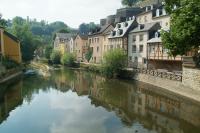 I really liked the tall bridges linking the parts of the city divided by the rivers. They looked gigantic and offered wonderful views. The green valley below looked almost surreal. Almost as if they were not part of the same municipality. As if the fortified upper town was one city, the lower town by the river - another, and the parks along the water - yet a third one. A fascinating combination! The upper town had its palaces, cathedrals, forts, mansions, and... shopping centres, and the lower town, the district of Grund, had the charm of a small village complete with picturesque little houses, narrow alleys and magnetic atmosphere. If I were looking for a fourth face of the city, it would be the district with the European institutions, like the European Court of Justice, the European Court of Auditors or the European Investment Bank. For the Grand Duchy of Luxembourg (the only grand duchy in the world) is the founding member of the European Union.
I really liked the tall bridges linking the parts of the city divided by the rivers. They looked gigantic and offered wonderful views. The green valley below looked almost surreal. Almost as if they were not part of the same municipality. As if the fortified upper town was one city, the lower town by the river - another, and the parks along the water - yet a third one. A fascinating combination! The upper town had its palaces, cathedrals, forts, mansions, and... shopping centres, and the lower town, the district of Grund, had the charm of a small village complete with picturesque little houses, narrow alleys and magnetic atmosphere. If I were looking for a fourth face of the city, it would be the district with the European institutions, like the European Court of Justice, the European Court of Auditors or the European Investment Bank. For the Grand Duchy of Luxembourg (the only grand duchy in the world) is the founding member of the European Union.
I was so lucky that I came during a jazz festival. It was great - many jazz parties in the streets! There were concerts in many places around the city. I have never seen so many jazz bands in one city in my life! They played live for free on numerous piazzas and squares, in front of prominent monuments or historically significant places. The culmination of this incredible party was the jazz night in the lower town. There, there were several concert platforms scattered around, but only like few hundred yards away from one another. Boats with trumpeters and other musicians were floating in the river playing funky and lively jazz. The place was packed! It was like a summer carnival. There was beer, wine, sausages, burgers, sweets being sold on every little corner of this magnificent, old and picturesque part of Luxembourg. Everyone had a super great fun and it was such a great surprise for me that I am dreaming of going back there to experience that again. It lasted until wee hours.
If the surrounding nature and the city position is not a sight enough, there are some smaller, or rather less spectacularly overwhelming but still very lovely places to see. There are the famous Cathedral of Notre Dame, the Grand Palace Ducal, the Neumuenster Abbey, the Bock Promotory and the Bock Casamates, the Petrusse Casamates, the Citadelle du St-Espirit, the Castle Bridge, the Church of St. Ulric, the Place d'Armes and the city hall. And one of my favourites, the Mill House in the lower town, the district of Grund.
The Chemin de la Corniche is amongst the best streets to admire the spectacular position of the city and the slate-roofed buildings of the lower district. Walking the best, if only sensible, way to see the city. Luxembourg is not large. Its population of about 75,000 people is packed densely - about 1,485 people per square kilometre. Plus, the areas around, otherwise spectacular, train station is not pretty. It is only for partying and cheap hotels.
|
Jul 15, 2005 02:00 PM Trier (DE) - the oldest German city
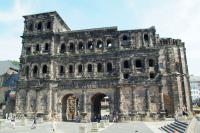 Trier (aka Trèves, aka Tréier, and formerly known as Augusta Treverorum) has the longest history as a city in Germany. Other cities in the country claim the title of the oldest city, however for relatively long periods at the beginning of their existence, they were just small settlements or military camps.
Trier (aka Trèves, aka Tréier, and formerly known as Augusta Treverorum) has the longest history as a city in Germany. Other cities in the country claim the title of the oldest city, however for relatively long periods at the beginning of their existence, they were just small settlements or military camps.
Anyway, the accurate date when Trier was founded is not clear. When the Roman Empire invaded and established Augusta Treverorum in 30 BC, the city was already there. It was probably founded a few centuries before by an Assyrian prince called Trebeta. When the Romans settled, they made the city the capital of Gallia Belgica and the prefecture of Gaul. Trier fell into the French hands in 870 AD, and later became the capital of the Holy Roman Empire, which developed from the Eastern Francia and a few other states, and later became the federated Germany. Yet in 1984, the authorities decided it was time to celebrate 2000th birthday.
Also, Trier has been the oldest seat of a bishop north of the Alps, and the archbishop was amongst the most powerful people in Europe in the Middle Ages. Its University opened in 1473 (and closed in 1797, only to re-open in 1975). Trier was the site where the borders of the regional territories of the Holy Roman Empire were demarcated in 1512. The city saw a few wars with the French, who sought domination in Europe, when the wars over who should take over the Spanish and Polish thrones. Of course trying to install an allied monarch.
I went to Trier during a weekend between business trips in Belgium and Luxembourg. I knew a little bit about the city but I did not expect to see so many sights from the ancient Roman times. And some in such an excellent condition! Weather was excellent and the city was packed with people, some of whom were day visitors from around Germany and the rest of the world. When I was passing by the long throne hall of the Roman Emperor Constantine, there was something that changed my life again.
The UNESCO-listed ancient Roman Baths built on the meadow in the middle of the town were my favourite spot. I remember that when I arrived in Trier and peeked into one of the souvenir shops to check the postcards (just to make sure I was going to see all the most important sights in the city), I saw the complete structure of the baths depicted on them. Not the ruined one, as it is in reality. So, when I arrived at the actual site, I was not quite sure I was at the right place. I thought that maybe there was another.
The baths were huge and I was impressed that they were erected using small red and cream bricks. Other ancient Roman Baths I had seen before had been built from large blocks of sandstone, marble, etc. I almost thought they might have been fake. But they were not. The baths were remarkable and huge. I really liked that visitors were free to wander around the site with no problem and that everything was so easily accessible.
On the first sight, I found it weird how the outstanding and incomparable ancient Roman Throne Hall of the emperor Constantine, having been converted into a church, was attached to the Baroque-Rokoko Place of Trier, built in the St.Petersburg's style. And although initially disturbing perhaps, the idea grew on me. For I began to understand that after the ancient Roman Empire fell, the world did not end. Life went on. Times changed. Several times over. So, isn't it fascinating how the grand monuments of the past instead of becoming 'sacred', actually extended their useful life.
I also liked the very laid back atmosphere of Trier. I came on a weekend day, so I expected a lot of relaxed people browsing through the old town, doing some shopping, chatting in the cafes, gossiping in the parks, and visitors admiring the stunning and rather extraordinary monuments. It was a sunny day too, which contributed to my good mood.
From the ancient Roman times the prominent sights, some of which managed to collect a rather cliché epithets of significance, included: the Porta Nigra - the best preserved Roman city gate north of the Alps; Roman Baths, one of which is the largest ancient Roman bath north of the Alps; and the Constantine's Throne Hall - the tallest and longest ancient Roman throne hall north of the Alps; the ancient Roman amphitheatre; and Roman Bridge over the Moselle River - the oldest bridge north of the Alps still in use. And I did not care. I really loved them all.
From the Middle Ages, there were: the Trier Cathedral (the Dom); the Church of Our Lady, one of the most important early Gothic churches in Germany, following the French Gothic style; the Saint Matthias Abbey - the only church north of the Alps (sic!) containing a grave of an apostle; and tread wheel cranes.
And there was more! I loved the colourful main market square with the St.Gangolf church and picturesque chocolate-box houses.
|
Jul 14, 2005 02:00 PM Luxembourg - the only Grand Duchy in the world
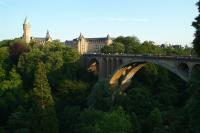 Luxembourg is one Europe’s most spectacularly situated capital cities. It spans two deep river valleys, where they meet, the Alzette and Petrusse. It seems almost impossible to build a city there and create a country of its own around it. The ancient Romans built a tower, which guarded two roads, which met there. Later, the land was granted to Siegfried I, who built a small castle there named Lucilinburhuc, giving routes to the existing name of the city and the country.
Luxembourg is one Europe’s most spectacularly situated capital cities. It spans two deep river valleys, where they meet, the Alzette and Petrusse. It seems almost impossible to build a city there and create a country of its own around it. The ancient Romans built a tower, which guarded two roads, which met there. Later, the land was granted to Siegfried I, who built a small castle there named Lucilinburhuc, giving routes to the existing name of the city and the country.
As its location at the trading and communication routes was a significant, the town received churches and fortification rather early in its history. The city walls and the complex system of fortifications grew and developed though the 10th and 14th centuries, which spectacularly failed under Philip the Good Burgundian in 1443. The Habsburgs then enhanced the defense structures of the Luxembourg Castle, which by 16th century was among the strongest fortifications in Europe. Sadly, the Treaty of London of 1867, required Luxembourg to demolish its defense systems. It took 16 years.
|
Jun 25, 2005 02:00 PM Riga (LV) - chocolate box houses
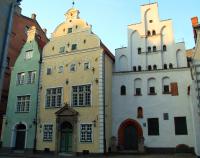 The first photograph of this report shows one of Riga's most famous landmarks - three very old buildings called The Three Brothers, which looked as if being taken from a fairy-tale. But there was more to see in the old town. The bright Riga Castle (the 14th century) set near the river and a park on the other side appeared extremely well maintained (now museums of Latvian History and Foreign Art). It was fascinating. The largest church in the Baltic states, the Lutheran Cathedral from the 13th century, with a golden clock on its bulky spire, took a vast chunk of space on one of the main squares. Riga had a few other interesting churches, including a Roman Catholic Cathedral started in the 15th century by the Teutonic Knights.
The first photograph of this report shows one of Riga's most famous landmarks - three very old buildings called The Three Brothers, which looked as if being taken from a fairy-tale. But there was more to see in the old town. The bright Riga Castle (the 14th century) set near the river and a park on the other side appeared extremely well maintained (now museums of Latvian History and Foreign Art). It was fascinating. The largest church in the Baltic states, the Lutheran Cathedral from the 13th century, with a golden clock on its bulky spire, took a vast chunk of space on one of the main squares. Riga had a few other interesting churches, including a Roman Catholic Cathedral started in the 15th century by the Teutonic Knights.
A great feature in the old town was the cylindric Powder Tower, the oldest piece that remains from the medieval 13th century city walls. But I loved the Guild Hall and the rows of picturesque little houses scattered around the town, many painted in vivid colours.
I spent a considerable amount of time just relaxing and watching people on of the squares of the old town, sitting at a beer garden sipping my Paulaner. Every now and again scoffing on a sausage or another beer snack. It was a great spot. Being surrounded by marvelous architecture representing centuries of history and just doing nothing (apart from killing time) was superb. This is what city breaks should be like. Two, three hours of history exploring narrow alleys, then long, long, lunch watching people and chatting to the locals, then again some more wandering around, browsing souvenir shops, taking pictures, seeing art in a museum or two, admiring religious architecture... Then dinner, night on the town... Yeah!
And Riga had plenty of cafes and beer gardens scattered around the historic centre, and the good thing about them was that they were frequented by the local population. Everyone is seriously spoiled for choice in terms of places to sit down and catch up on gossip.
|
Jun 24, 2005 02:00 PM Riga (LV) - Latvia's pretty capital
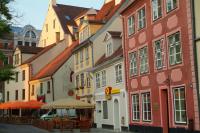 I loved Riga. It had this great Hanseatic feel and the squares filled with beer places offering the Paulaner hefe weizen! It was a great pleasure to wander around the old town.
I loved Riga. It had this great Hanseatic feel and the squares filled with beer places offering the Paulaner hefe weizen! It was a great pleasure to wander around the old town.
The matchless Art Nouveau city of Riga was one of the seven chief cities of the Hanseatic League. The League was an association of trade cities maintaining a monopoly of commerce in the Northern Europe between the 13th and 16th centuries. After Riga was granted town rights in 1225, it soon became a key trading post for the Oder of Livonian Brothers of the Sword. As the order, combined with the Teutonic Knights, fell after the wars with the United Kingdom of Poland and Lithuania, Riga maintained a status of a Free Imperial City, then joined Poland and eventually was conquered by Sweden. Until early 18th century, Riga was Sweden's largest city, before being scooped by Russia's Tsar Peter the Great in 1721. It was then Russia's third largest city, after Moscow and the brand new St Petersburg. The changing of hands from the Germany-influenced Hanseatic League to Poland, then to Sweden and to Russia, left a considereably diversified footprint in the city's landscape and skyline. This is why it is so interesting to explore today.
The core UNESCO-listed historic centre is relatively compact and can be visited in a few hours. I managed to sweep it twice in the morning, snapping along, and then made a mistake and went to see parts of the upcountry by train. The train was excruciatingly slow, like in the old Soviet Union and the countries of the Warsaw Pact! This brought a few funny memories from childhood, so I have no regrets at all - apart from taking so long to get a few miles outside town. But I so wanted to visit the castles in Sigulda and Krimulda. They were positively interesting, but I expected a little more... A guess a little more grandeur, mystery, and association with the Middle Ages.
For some reason, I really liked the square about the Townhall. Nearby there were two grand merchant houses (The House of Blackheads) built in the 14th century restored to their former glory (picture below) - standing close to possibly the ugliest building in the world, now housing the Museum of Occupation. Perhaps it was the contrast that stunned me.
The Townhall was very elegant but simple in its form. Almost majestic. The merchant houses with their red, almost triangular facades, richly decorated with reliefs and ornaments typical for an Hanseatic trading building, were lovely. My mind suddenly demanded to see more of them around. Perhaps in the past there were more of them. And then, the grey, cubic building of the museum was impossibly cold and austere.
The city was super clean. Every morning I saw the locals sweeping the streets carefully, almost as if the entire street was an extention of their living rooms. And then even during the day, little if at all rubbish accumulated on the pavements and other public areas. What was eventually swept was some dust and leaves, really.
It was also great to see how quickly Latvia recovered from the oppression of communism. The old town was in a great shape, few buildings required repairs (the Soviet Union did not care much about the historical buildings outside Moscow) and the number of little businesses, which mashroomed on every corner was comforting and reassuring that the society was free and was returning to normality.
|
Jun 24, 2005 02:00 PM Krimulda (LV) - castle, valley and woods
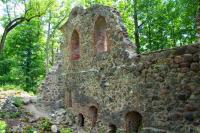 Just 55 km from Riga, there were forrests housing two genuinely interesting castles, the Sigulda and Krimulda. The first one is situated in a lovely valley of the primeval Gauja river, which is spanned by a cable car offering spectacular views. The castle itself looks modern and extremely well maintained, but the site of a former fortress right next to it are mysterious and a little spooky. The Krimulda Castle, badly ruined, on the other side of the cable car, is even spookier. The ruins are extensive but not particularly fabulous. The nature surrounding it makes up for it, though. There are also some fascinating wooden mansions and manor houses nearby as well. Slightly beyond, on the same side of the valley, there is the reconstructed Turaida Castle (pictured above) built by the archibishop of Riga in 1214, which had lain in ruin for a few centuries. There is a good hike from the Krimulda Castle to the Turaida Castle, whose path leads through the woods. Brilliant!
Just 55 km from Riga, there were forrests housing two genuinely interesting castles, the Sigulda and Krimulda. The first one is situated in a lovely valley of the primeval Gauja river, which is spanned by a cable car offering spectacular views. The castle itself looks modern and extremely well maintained, but the site of a former fortress right next to it are mysterious and a little spooky. The Krimulda Castle, badly ruined, on the other side of the cable car, is even spookier. The ruins are extensive but not particularly fabulous. The nature surrounding it makes up for it, though. There are also some fascinating wooden mansions and manor houses nearby as well. Slightly beyond, on the same side of the valley, there is the reconstructed Turaida Castle (pictured above) built by the archibishop of Riga in 1214, which had lain in ruin for a few centuries. There is a good hike from the Krimulda Castle to the Turaida Castle, whose path leads through the woods. Brilliant!
|
Jun 09, 2005 02:00 PM Mbabane (SZ) - the capital city - not pretty
 Mbabane is the kingdom’s official capital city because the government sits here, however the parliament and the king’s village are located in different places.
Mbabane is the kingdom’s official capital city because the government sits here, however the parliament and the king’s village are located in different places.
I only had a quick drive through the city and, apart from it being modern place without any particularly distinguishing features, it has nothing to offer. Not even in tourist terms.
The governmental office blocs are grotty, ugly and look like underinvested and long forgotten hospital buildings erected in the seventies of the last century. I was out of there in no time.
|
Jun 09, 2005 02:00 PM Mlilwane Wildlife Sanctuary (SZ) - super
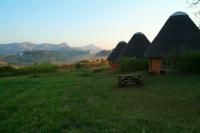 This is a small natural reserve created in 1950's by Ted Reilly. Many sources claim it is a private reserve but they forget to mention that His Royal Majesty the King of Swaziland owns it, as all other land in Swaziland.
This is a small natural reserve created in 1950's by Ted Reilly. Many sources claim it is a private reserve but they forget to mention that His Royal Majesty the King of Swaziland owns it, as all other land in Swaziland.
There are two accommodation options in the sanctuary - Sondzela Backpackers and Mlilwane Rest Camp. The latter is more luxurious and has a restaurant.
Both places have very friendly staff, who can arrange the whole range of activities in the reserve. They are not paid much (in the range of SZL 500 - 700 a month) and they are so friendly – that is in European and North American terms a paradox. Particularly Patrick, a waiter from the rest camp restaurant (The Hippo Haunt) was very friendly. He had a perfect and genuine handshake, and I can never overemphasize how important good handshakes are for me.
He would like to be a waiter, but he needs to have all the proper papers indicating his qualifications, which he currently has not. He intends to go to school to do them, but this means that he cannot continue with his employment in the park. I thought it was strange and advised him to speak to the owners if they let him do a part job, so he could attend the school and still earn some money to cover the cost of this education.
He apparently needed to save some SZL 2,000 (USD 300, EUR 245) for this school and he had SZL 700 (USD 104, EUR 86) saved, which was equivalent to his monthly income.
The game in the park is not large or plentiful but one can get very close to the animals. Most of them are antelopes and warthogs.
In the morning, I went on a game drive in a old land rover. It took two hours of driving among tall grass looking for gazelles and antelopes. My favourite though was a five meters tall male giraffe. It was gorgeous and not afraid of the camera. I had a zoom lens on and the giraffe was so close that it was not the best option at that time.
It was the first time that I saw a giraffe dark like that. It was such a pity that weather was not good and the pictures were a bit dark and grey.
I went high in the mountains with the car to see what the landscape looks like that. From the top of the mountains, I could see a large part of the Valley of Hotels, the Mantenga Falls, and the Mantenga Village.
As a bonus, I could also have a closer look at the execution mountain, which was used in the past to punish criminals, mostly murderers. After it was proven they killed someone purposely, they were escorted to the top of the mountain and asked to jump. The escorting party carried spires with them just in case the criminals needed an extra encouragement to jump from the top.
This practice, I was told, is no longer in practice.
At night, the lodges get lively and fire is made. It is used for cooking food and keeping warm. On Friday, when it got really cold and weather did not let any sunshine in, it was a great idea.
I sat at the campfire and relaxed. It felt like the old times when I was spending chilly summer nights in the mountains in Poland when I was a kid. The difference was that in Swaziland they were burning whole tree trunks.
Staying at backpackers unmistakably means meeting travellers who are often globetrotters. They have magnificent stories to tell and most importantly the hints where to travel so one can have some more stories to tell of their own. There was this big truck driver taking people through Africa who recommended exceptionally strongly Rwanda, Uganda and Zimbabwe and of course Malawi. Something is telling me that I will seriously consider implementing this recommendation.
|
Jun 08, 2005 02:00 PM Manzini (SZ) - First time in Swaziland
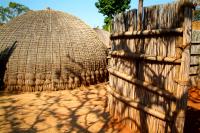 Modern town of Manzini is a lively place with a church as the only interesting or standing out piece of architecture. It is the international gateway to Swaziland since the international airport is situated there. I actually did not spend there any time at all. Just took a taxi and went to the Sondzela Backpackers lodge based within the Mlilwane Wildlife Sanctuary.
Modern town of Manzini is a lively place with a church as the only interesting or standing out piece of architecture. It is the international gateway to Swaziland since the international airport is situated there. I actually did not spend there any time at all. Just took a taxi and went to the Sondzela Backpackers lodge based within the Mlilwane Wildlife Sanctuary.
The taxi driver from Manzini, Musa (31), seemed okay so I offered to make a business deal with him. I wanted him to take me around his country for the day.
It came to him as a shock and he was not actually sure what to show me. He was expecting from me to tell him where I wanted to go. Such a taxi driver approach! He confessed to me that never in his life was he asked to this king of service. I told him that I did that all the time, because taking pictures and driving is not necessarily fully compatible and driving in a foreign country on the unknown territory is work, and I was on holiday.
My guidebook was quite poor on Swaziland so I myself struggled to decide what I wanted to see. His response came to me as a shock, too. I was hoping a local would just take my hand and lead me to the country's flagship landmarks and sights.
I had a second look in my book, and instructed him to take me the Ezulwini Valley, where there should be a few things to see, and then perhaps to Mbabane, the capital city of the kingdom. He did not protest, so we went, but he kept quiet all the time.
Well, Musa had never had ostrich as a meal and did not know what wine was, so he was not a fountain of knowledge exactly. At least I could take him to a restaurant where we could have an ostrich steak. And I am still not sure about the wine business, he might have pulled my leg on this one.
|
Jun 08, 2005 02:00 PM Elzuwini Valley (SZ) - it's like Las Vegas
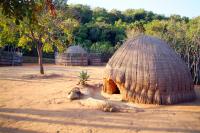 Ezulwini Valley means the Valley of Heaven, but in reality, it means the Valley of Hotels. It is filled with top range hotels and casinos. I struggled to see anything else there but commerce, commerce, commerce.
Ezulwini Valley means the Valley of Heaven, but in reality, it means the Valley of Hotels. It is filled with top range hotels and casinos. I struggled to see anything else there but commerce, commerce, commerce.
One has to go to the mountains and see the valley from the top, where the air is clearer and the commerce cannot be smelt. From the mountains, the valley is actually more picturesque than it practically is.
The business and commerce orientated valley was in fact of some use to me. I wanted to have nice lunch and I wanted an ostrich steak. Musa again did not know exactly where such restaurant would be, but as soon as I spotted a shopping complex and the Quatermain's Restaurant & Pub, I thought it should be close enough.
It was. They had an entire range of things on the menu, and the only game-like food was the ostrich steak. How lucky is that?! Although, we debated a little over the menu and asked a few questions about what Musa could potentially order, but in the end, he chose the ostrich.
It was good, but I had better. It was of a good size and the service was prompt. I was happy and my taxi driver could not believe he just had an ostrich, which to him tasted like beef.
|
Page:
 85 86 87 88 89 90 91 92 93 94 95
85 86 87 88 89 90 91 92 93 94 95

|
|
|
